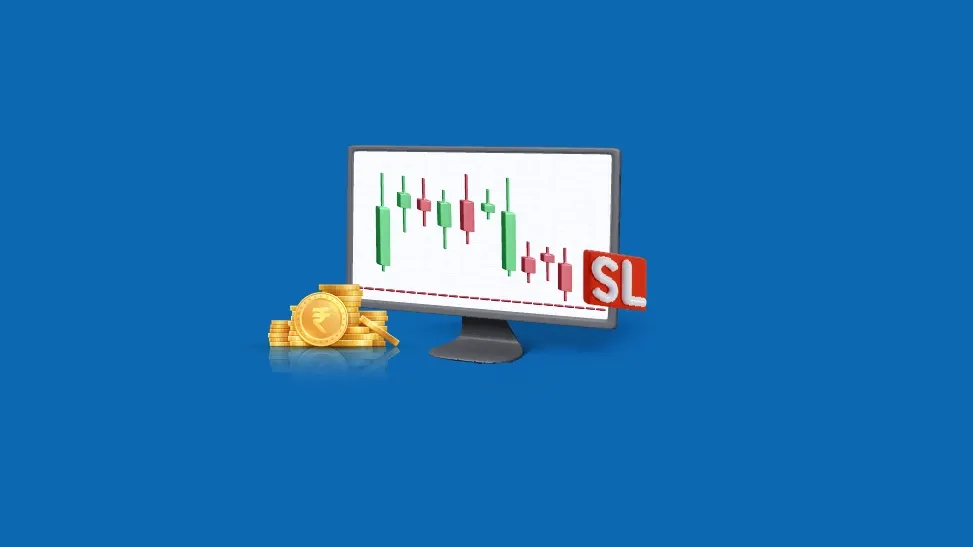What is Stop Loss?

- Published Date: September 30, 2024
- Updated Date: November 24, 2025
- By Team Choice
Successful traders understand their limitations while trading in the stock market. While you hope for positive gains, you should also be ready for probable losses. Effective risk management is necessary to ensure you don't lose more than you can tolerate. A stop-loss order automatically helps you get out of the trade when the loss becomes unbearable. Instead of placing a market order that executes immediately, a stop loss order will help you manage risk and execute your trade at a desirable price. Let’s explore what a stop-loss order is for profitable trading.
What is Stop Loss in Share Market?
Stop loss order meaning is explicit. Stop loss is a type of order that traders can use to limit their losses and lock their profit on an existing position. The purpose of a stop-loss order is to control risk exposure.
For example, you can buy a stock and put a stop loss order specifying a stop price of 10% below the purchased price. During market trading, as soon as the stock price drops to the 10% level, the stop loss order will be triggered automatically to sell the stock at the best available market price.
Who Can Use Stop Loss Order?
This stop-loss order is effective for risk management because the security is automatically sold once it is a specific price. It allows you to let go of stocks with more losing potential. Traders can use it to hedge downside risk and keep losses manageable.
A stop-loss order with the correct stop price prevents a trader from making emotion-driven decisions. You will not hold on to losing investment when there is a stop-loss order. It is beneficial for traders who cannot sit around and monitor their investment, watching the market movement every minute.
You can also use a stop-loss order to trigger a security purchase. The buy-stop order automatically lets you buy stock once it reaches a specified price. If you want to enter a position at a specific price point, you can set up a stop-loss order to purchase an underlying security.
How Stop Loss Order Works?
The stop loss order works to manage risk by exiting the position if the security price starts moving in the direction opposite to the position you have taken. A stop-loss order to sell instructs your broker to sell the stock if the market price drops below the specified stock price. If you want to set up a stop loss order to buy, the stop price must be above the current market price.
Stop Loss Order Example
Let's understand the stop loss meaning with an example. Suppose you buy 100 shares of a company at ₹ 500 per share. You were hoping for the stock to appreciate. However, you see that the price starts to decline. Based on your risk level, you determine that you can tolerate a 10% loss. So, in this case, you must set up your stop loss at ₹450. When the stock price reaches ₹ 450, the stop loss order is triggered automatically, selling all your shares at ₹ 450. Here, you would have incurred a loss of ₹50. But in a declining market, you would have prevented the loss with this stop-loss order.
The purpose of a stop-loss order is not to stop the loss. Instead, this order helps you prevent losses you cannot tolerate.
How to Calculate Stop Loss?
Calculating the right price to set up a stop-loss order differs from trader to trader. You must consider the following factors:
- Risk tolerance - To set up a stop loss order, determine the percentage of your investment you are willing to risk on a losing trade. With equity trading, you must choose the point beyond which you cannot lose.
- Liquidity of stock – A stop-loss order can be executed only if buyers want to purchase the stock. The number of buyers may be limited for low-volume stocks that are not liquid. In such cases, your stop-loss order may not be executed successfully due to a lack of buyers.
- Position size - Large positions with low stock volume can be difficult to execute. So, determine the position size for your stop loss order depending on its liquidity.
- Volatility - During market volatility, the market prices change almost instantaneously. Your stop-loss order should be wide enough for such volatile stocks to avoid being triggered prematurely. Otherwise, you may not be able to capitalise on potential gains. For example, a stock may suddenly dip in value, after which it can gain a large momentum. If your stop loss order is not wide enough, it will be triggered prematurely, stopping you from benefiting from the later gains.
- Technical analysis - The stop loss order doesn't consider the fundamental strength of a stock. It is only determined based on the price movement. So, you need technical analysis to find your stock's support and resistance levels. Explore movie averages, trend lines, and other technical indicators e to speculate on stock price movement. Generally, traders set the stop loss below the support level to ensure room for fluctuations.
- Average true range ATR - ATR measures stock volatility considering the price gaps. Many traders set their stop loss at multiples of ATR.
- Market condition - You must consider the overall market condition before placing your stop loss order. When you expect big news to hit the market, you can set up a wide-stop loss order to benefit from any later trading opportunity.
- Backtesting - Backtesting using historical data is an excellent strategy to fine-tune the stock price and test the validity of the stop loss level.
For example, if you have ₹1,00,000 to invest and decide to risk 2%, your maximum loss per trade is ₹2,000. If you buy shares at ₹500 each, you would purchase 200 shares (₹1,00,000 ÷ ₹500). To limit your loss to ₹2,000, the stop loss should be set at ₹490 per share (₹500 - ₹10), ensuring that the total loss remains within your risk limit (₹10 × 200 shares = ₹2,000).
Benefits of Stop Loss
Some of the advantages of using stop loss order are:
- Minimise risk and protect your trading capital from significant losses
- Improve risk management with stop loss order aligning with your investment goals.
- Avoid emotional decisions with an effective stop-loss order.
Limitations of Stop Loss
Some of the limitations of a stop-loss order are:
- In a volatile market, a stop loss order may be triggered prematurely, resulting in early exits that stop you from earning potential gains.
- If the execution price differs from the stop price, slippage occurs, and your stop loss order may be executed at a different price, increasing your loss.
- Some stocks may skip over your stop loss order, which can prevent the trigger of the stop loss order and result in gapping. This can happen when major market news or events hit the market.
- You must watch the market constantly and change the stop love level to minimise the losses. This can increase your stress and anxiety with the stock trading system.
How to Put a Stop Loss Order?
Putting in a stop-loss order depends on the brokerage platform you use. Generally, stop brokers provide stop-loss SL order options for delivery and intraday trades. When you place an order on the brokerage platform, choose SL order and mention the stop price. You can also set up stop-loss orders on existing open positions.
Without a stop order, your market order will be executed immediately at the market price. The sell order with stop loss will be executed when the stock's market price drops to match the stop price. Similarly, when the market price rises to meet the stop price, the buy order will be executed.
Conclusion
A stop-loss order helps you automatically exit a trade when a stock's price reaches a specified level, preventing losses that exceed your risk tolerance. You can calculate and set effective stop-loss orders by understanding risk tolerance, market conditions, and stock volatility. Integrating stop-loss orders into your trading strategy promotes disciplined decision-making, safeguards your capital, and enhances long-term profitability.
Want to explore stock market investments? Get started with expert advice and guidance through the Choice platform.
Recommended for you

Covered Call Strategy Explained

FII DII Data - Live Data

Share Market Prediction For Tomorrow
